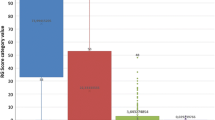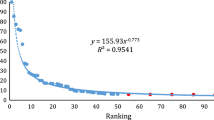Abstract
International academic awards are not only compelling signs of personal academic excellence, but also play a significant role in evaluating the performance of institutions and countries. However, limited literature about awards in social sciences means that many major international academic awards are still unrecognized. Here we collect 180 international academic awards in eight subjects and gauge their relative reputations through online surveys. Moreover, we visualize the awards network based on the relative reputation scores and the number of co-awardees among them by using Gephi software. Finally, we adopt a statistical approach to analyze the structure of the awards network and find that the co-awardee frequencies follow a power-law distribution, which indicates that the awards network is a scale-free network. Our result suggests that a hierarchical status exists among international academic awards in social sciences, which may help us enhance the understanding of the Matthew effect in the academic awards system.
Similar content being viewed by others
References
Abramo, G., D’Angelo, C. A., & Caprasecca, A. (2009). The contribution of star scientists to overall sex differences in research productivity. Scientometrics, 81(1), 137–156.
Barabási, A. L. (2009). Scale-free networks: A decade and beyond. Science, 325(5939), 412–413.
Barabási, A. L., & Albert, R. (1999). Emergence of scaling in random networks. Science, 286(5439), 509–512.
Barabási, A. L., Jeong, H., Néda, Z., Ravasz, E., Schubert, A., & Vicsek, T. (2002). Evolution of the social network of scientific collaborations. Physica A: Statistical Mechanics and its Applications, 311(3–4), 590–614.
Bastian, M., Heymann, S., & Jacomy, M. (2009). Gephi: An open source software for exploring and manipulating networks. Proceedings of the Third International ICWSM Conference, 8, 361–362.
Best, J. (2008). Prize proliferation. Sociological Forum, 23(1), 1–27.
Bourdieu, P. (1975). The specificity of the scientific field and the social conditions of the progress of reason. Information (International Social Science Council), 14(6), 19–47.
Cainelli, G., Maggioni, M. A., Uberti, T. E., & De Felice, A. (2015). The strength of strong ties: How co-authorship affect productivity of academic economists. Scientometrics, 102(1), 673–699.
Charlton, B. G. (2007). Which are the best nations and institutions for revolutionary science 1987–2006? Analysis using a combined metric of Nobel prizes, Fields medals, Lasker awards and Turing awards (NFLT metric). Medical Hypotheses, 68(6), 1191–1194.
Clauset, A., Shalizi, C. R., & Newman, M. E. (2009). Power-law distributions in empirical data. SIAM review, 51(4), 661–703.
Cole, S., & Cole, J. R. (1967). Scientific output and recognition: A study in the operation of the reward system in science. American Sociological Review, 32(3), 377–390.
Cole, J. R., & Cole, S. (1973). Social stratification in science. Chicago, IL: University of Chicago Press.
Coupé, T. (2013). Peer review versus citations—An analysis of best paper prizes. Research Policy, 42(1), 295–301.
Ding, Y. (2011). Scientific collaboration and endorsement: Network analysis of co-authorship and citation networks. Journal of Informetrics, 5(1), 187–203.
Frey, B. S. (2006). Giving and receiving awards. Perspectives on Psychological Science, 1(4), 377–388.
Frey, B. S., & Neckermann, S. (2009). Awards: A view from economics. In G. Brennan & G. Eusepi (Eds.), The economics of ethics (pp. 73–88). Cheltenham: Edward Elgar.
Frey, B. S., & Neckermann, S. (2010). Awards as signals (No. CESifo Working Paper: 3229). CESifo. Retrieved from http://www.econstor.eu/handle/10419/46399.
Garfield, E. (2009). From the science of science to Scientometrics visualizing the history of science with HistCite software. Journal of Informetrics, 3(3), 173–179.
Glänzel, W. (2001). National characteristics in international scientific co-authorship relations. Scientometrics, 51(1), 69–115.
Glänzel, W., & Schubert, A. (2004). Analysing scientific networks through co-authorship. In H. F. Moed, W. Glänzel, & U. Schmoch (Eds.), Handbook of quantitative science and technology research (pp. 257–276). Dordrecht: Kluwer Academic Publishers/Springer.
Goldstein, M. L., Morris, S. A., & Yen, G. G. (2004). Problems with fitting to the power-law distribution. The European Physical Journal B-Condensed Matter and Complex Systems, 41(2), 255–258.
Hagstrom, W. O. (1965). The Scientific Community. New York: Basic Books
Kim, J., Tao, L., Lee, S. H., & Diesner, J. (2016). Evolution and structure of scientific co-publishing network in Korea between 1948–2011. Scientometrics, 107(1), 27–41.
Latour, B., & Woolgar, S. (1979). Laboratory life: The social construction of scientific facts. Beverly Hills, CA: Sage.
Liu, N. C., & Cheng, Y. (2005). Academic ranking of world universities—Methodologies and problems. Higher Education in Europe, 30(2), 127–136.
Lotka, A. J. (1926). The frequency distribution of scientific productivity. Journal of the Washington Academy of Sciences, 16(12), 317–323.
Mahassen, N. (2014). A quantitative approach to world university rankings. Retrieved from http://cwur.org/methodology/preprint.pdf.
Mazloumian, A., Eom, Y. H., Helbing, D., Lozano, S., & Fortunato, S. (2011). How citation boosts promote scientific paradigm shifts and Nobel prizes. PLoS ONE, 6(5), e18975.
Merton, R. K. (1957). Priorities in scientific discovery: A chapter in the sociology of science. American Sociological Review, 22(6), 635–659.
Merton, R. K. (1968). The Matthew effect in science. Science, 159(3810), 56–63.
Merton, R. K. (1988). The Matthew effect in science, II: Cumulative advantage and the symbolism of intellectual property. ISIS: Journal of the History of Science in Society, 79(4), 606–623.
Mixon, F. G., Jr., & Updahyaya, K. P. (2011). From London to the continent: Ranking European economics departments on the basis of prestigious medals and awards. Economia, 14(2), 119–126.
Otte, E., & Rousseau, R. (2002). Social network analysis: A powerful strategy, also for the information sciences. Journal of Information Science, 28(6), 441–453.
Price, D. (1963). Little science, big science. New York: Columbia University Press.
Price, D. (1965). Networks of science paper. Science, 149(3683), 510–515.
Redner, S. (1998). How popular is your paper? An empirical study of the citation distribution. The European Physical Journal B-Condensed Matter and Complex Systems, 4(2), 131–134.
Ribeiro, L. C., Rapini, M. S., Silva, L. A., & Albuquerque, E. M. (2018). Growth patterns of the network of international collaboration in science. Scientometrics, 114(1), 159–179.
Richter, M. (1972). Science as a cultural process. Cambridge, MA: Schenkman Publishing Co.
Rodríguez-Navarro, A. (2016). Research assessment based on infrequent achievements: A comparison of the United States and Europe in terms of highly cited papers and Nobel Prizes. Journal of the Association for Information Science and Technology, 67(3), 731–740.
Ronda-Pupo, G. A., & Katz, J. S. (2017). The scaling relationship between degree centrality of countries and their citation-based performance on Management Information Systems. Scientometrics, 112(3), 1285–1299.
Ronda-Pupo, G. A., & Pham, T. (2018). The evolutions of the rich get richer and the fit get richer phenomena in scholarly networks: The case of the strategic management journal. Scientometrics, 116(1), 363–383.
Schlagberger, E. M., Bornmann, L., & Bauer, J. (2016). At what institutions did Nobel laureates do their prize-winning work? An analysis of biographical information on Nobel laureates from 1994 to 2014. Scientometrics, 109(2), 723–767.
Shelton, R. D., & Holdridge, G. M. (2004). The US-EU race for leadership of science and technology: Qualitative and quantitative indicators. Scientometrics, 60(3), 353–363.
The United States National Research Council Committee on an Assessment of Research Doctorate Programs. (2011). In Ostriker, J. P., Kuh, C. V. & Voytuk, J. A. (Eds.) A data-based assessment of research-doctorate programs in the United States. Washington (DC): National Academies Press (US). Retrieved from http://www.ncbi.nlm.nih.gov/books/NBK83404/.
van Raan, A. F. J. (2013). Universities scale like cities. Plos ONE, 8(3), e59384.
Watts, D. J. (1999). Networks, dynamics, and the small-world phenomenon. American Journal of Sociology, 105(2), 493–527.
Yair, G., Gueta, N., & Davidovitch, N. (2017). The law of limited excellence: Publication productivity of Israel Prize laureates in the life and exact sciences. Scientometrics, 113(1), 299–311.
Zheng, J., & Liu, N. (2015). Mapping of important international academic awards. Scientometrics, 104(3), 763–791.
Zuckerman, H. (1992). The proliferation of prizes: Nobel complements and Nobel surrogates in the reward system of science. Theoretical Medicine, 13(2), 217–231.
Zuckerman, H. (1995). Scientific elite: Nobel Laureates in the United States. New Brunswick, NJ: Transaction Publishers.
Author information
Authors and Affiliations
Corresponding author
Appendices
Appendix 1
See Table 4.
Appendix 2: Listing of the 180 international academic awards in social sciences and their average reputation scores
See Table 5, 6, 7, 8, 9, 10, 11, 12, and 13.
Rights and permissions
About this article
Cite this article
Jiang, F., Liu, N. The hierarchical status of international academic awards in social sciences. Scientometrics 117, 2091–2115 (2018). https://doi.org/10.1007/s11192-018-2928-y
Received:
Published:
Issue Date:
DOI: https://doi.org/10.1007/s11192-018-2928-y












